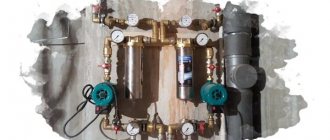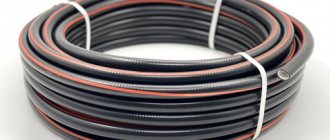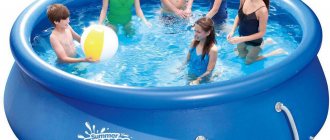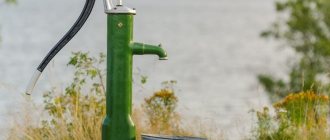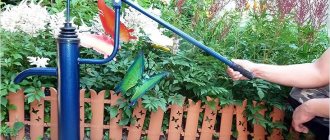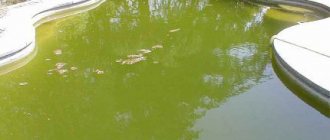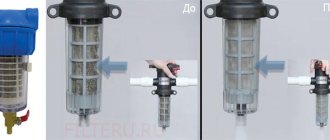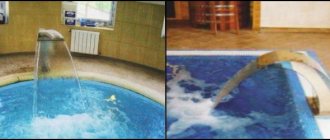Thanks to the variety of offers in different price categories, today swimming pools have appeared on almost every site. Large stationary swimming pools set up by wealthy people, independent systems connected to water supply and sewerage, and their operation is automatic. But inflatable or frame models, by magic, do not fill or empty; here you need to make an effort. This is where special equipment comes to the rescue - pumps for pumping out water.
Which pumps are suitable for pumping water from the bottom of the pool
There are several types of water pumps; depending on the operating principle and equipment, they are designed for different applications. For pumping water from swimming pools and other containers in which the water is not clean, but not completely littered, there are self-priming drainage pumps.
The pump can be a special one, usually produced by pool manufacturers, or a household pump, designed for widespread use. Depending on the cost of the reservoir, a pump for pumping out water may be included, but this is in expensive frame models. The bulk of the units have the same manufacturer, but are supplied separately.
Manufacturers: Intex, Bestway
Pool pumps are produced by several companies, usually manufacturers of pools and components.
- Intex is a Chinese company, supplier of inflatable and prefabricated swimming pools and components. Offers various types of pool pumps made of high-strength plastic. The company also offers various types of vacuum cleaners for Intex pools.
- Bestway was originally a Chinese-American joint venture specializing in frame and inflatable household pools. Today it is considered a purely Chinese company supplying high-quality, affordable products for wide consumption. The company’s drainers are compact, quite powerful, and made of special plastic.
- Gardena is a well-known German company that produces equipment for garden plots. One of the directions is the production of pumps, including drainage ones. They are universal and can also be used for pumping water out of swimming pools.
- Gilex is a domestic pump manufacturer that produces industrial and household units. The company's line includes a lot of drainage pumps for domestic needs, which will do an excellent job with a swimming pool.
When choosing a drainage pump, pay attention not only to its power and performance, but also to its intended use. To drain the pool a couple of times a season, the cheapest, low-power model is enough. And if you plan to use it for household needs, it’s worth buying a model with good throughput and a long working life.
Overview of possible options
A pool in the basement, garden or home should ensure the safety of swimmers. Therefore, the presence of blooming water in the bowl that does not meet the requirements of sanitary and hygienic standards should under no circumstances be allowed. To prevent problems and timely cleaning of the walls of the bowl, water is periodically pumped out of the pool using various pumps.
1. Immersion format – a combination of simple design and impressive functionality
Using submersible pumping equipment for his pool, the developer will be able to pump water through a grate located in his body. Using the equipment is very simple - it is placed on the bottom of the pool and the motor is started, after which the water is pumped and supplied upward. The device is used not only for pools, but also for draining wells, cesspools, basements and cellars.
Among the advantages of the pump, it is worth highlighting its prevalence, light weight, compact dimensions and affordability. The disadvantages also cannot be ignored. They are represented by limited performance.
2. Surface pump – ease of use and high power
If for some reason the developer does not consider the possibility of using submersible equipment, he still has the option of using a surface pump. It has a completely different format. The equipment is placed above the surface of the water surface, and a special flank connected to the body is lowered into a bowl of water. When the equipment motor is started, water begins to be pumped out of the tank.
Universal solutions
In addition to pumping water, pumping equipment in the pool must perform other functions. This is ensuring the circulation of water, distributing chemicals in its thickness, mixing heated and cold layers, supplying liquid to the purification and filtration system, etc. Therefore, far-sighted developers initially equip pools with universal devices capable of operating in several modes.
Such pumps allow, if necessary, to drain the tank by completely pumping out all the water from it, and also allow for efficient circulation in it. The equipment is quite expensive, but its functionality, practicality and multitasking fully recoup all investments made by the developer.
Operating modes of universal pumps
When choosing a universal pump to equip a pool, the pool owner can set several operating modes. Thus, operating in the “circulation” mode, the pump solves the following problems:
— uniform heating of water;
— its supply to the filter system;
— prevention of flowering;
- help with cleaning.
The "heating" mode can also be used by the user. It involves work both on pumping water and draining it, and also helps in the process of mixing the supplied layers of water. As a result, the temperature at different depths will be the same and swimmers in the pool will feel maximum comfort during water fun.
Popular models with sand filter
We offer a rating of the most popular modifications of pumps, which are preferred by owners of private pools around the world.
Model #1 - Intex
The international Chinese corporation Intex is the largest manufacturer of inflatable and frame pools. Affordable price and high quality, durability are well-deserved characteristics of Intex brand products.
The resource of the paper cartridge is enough for two to three weeks, with an average intensity of use of the pool
Suitable for small swimming pools.
Main characteristics:
- mains voltage - 220V;
- flow rate - 5600 l/h;
- Case material: plastic.
The fully finished pump is mainly used for inflatable and frame pools. Has threaded connection of pipes. Used for short-term, seasonal cleaning and circulation, after which it is put away for storage.
Filter container for filling with sand. Quartz sand lasts from 2 to 4 years, depending on the mass of the sand and the intensity of use
One of the most common options for home use.
Main characteristics:
- mains voltage - 220V;
- flow rate - 8000 l/h;
- Case material: plastic.
The pump is equipped with a timer for automatic on/off. The filter can use quartz or glass sand. The connection of the pipes is threaded.
The chlorine generator uses regular table salt instead of chemicals
Quite a serious unit for an average pool.
Main characteristics:
- mains voltage - 220V;
- flow rate - 10000 l/h;
- Case material: plastic.
Produces 11 g/h of chlorine, effectively fights microorganisms, mucus, and algae. The main filter element is quartz or glass sand.
Model #2 – Kripsol
The next manufacturer of swimming pool equipment is the Spanish Kripsol. The company's products are widely known throughout the world and are available in a wide range.
Sand filter cleaning fineness – 20-30 microns. Filled with 0.5-1 mm sand and designed for medium-sized pools
Main technical characteristics:
- mains voltage - 220V;
- flow rate - 14500 l/h;
- body material - polypropylene.
The sand filter holds 125 kg of sand. The unit is equipped with a six-position valve. There is a pressure gauge.
A powerful and very capacious filter for large pools. The filter diameter is 900mm, which allows you to fill in 325 kg of sand
A powerful and durable filter; high-quality materials are used in the manufacture of the pump.
Main characteristics:
- mains voltage - 380V;
- flow rate - 30,000 l/h;
- body material: fiberglass reinforced polyester.
The filtration unit is intended for private and small public swimming pools. The unit is equipped with a multi-port valve for cleaning and maintenance.
Model #3 - Emaux
The Hong Kong company Emaux is a large manufacturer of swimming pools and equipment for them; the company has representative offices in 70 countries around the world. List of manufactured products: from swimming pools to attractions.
With continuous operation of such a pump, the cartridge will last for a month, so you should take care in advance of a sufficient supply of filtering devices
Main characteristics:
- mains voltage - 220V;
- flow rate - 5600 l/h;
- Case material: plastic.
The housing material is UV and moisture resistant. The unit is equipped with two air release valves.
A device with a stable base and low weight, suitable for small inflatable pools.
This installation is intended for modest pools, the capacity of which does not exceed 100 cubic meters. An artificial pond with a volume of up to 65 cubic meters is optimal.
A sand pump can purify water until it is clear, but microorganisms will remain.
Main characteristics:
- mains voltage - 220V;
- flow rate - 13000 l/h;
- body material: polyethylene.
The volume of loaded sand is 145 kg. The delivery set includes a pressure gauge and a four-position valve. Cleaning fineness – 20-30 microns.
Model #4 - Behncke
Behncke is a German manufacturer of water-related equipment. It is one of the highest quality suppliers on the Russian market.
The family business was founded in 1946 and is currently managed by the third generation of owners.
For ease of use, the device is mounted on a platform. Everything is done very high quality and thoughtfully, serious equipment and serious money
Main characteristics:
- mains voltage - 380V;
- flow rate - 32000 l/h;
- body material - polypropylene.
The filter unit holds 375 kg of sand. A six-position valve controls various operating modes. Suitable for swimming pools with a volume of up to 160 m3. When choosing filter units, you need to focus on the cleaning method.
Cartridge and cassette filters are suitable for small volumes of inflatable and frame pools. Easy to maintain and do not require sewerage.
Sand filters are suitable for medium and large volumes, up to public swimming pools. They are distinguished by their impressive mass and often require a three-phase connection.
Required number of pumps
The amount of equipment is directly proportional to the size and volume of the reservoir. One pump for an inflatable pool or frame-type pond, supplied in the kit, will cope with its task. The water will go through a full cycle through all cleaning and heating systems in 6 hours.
Pool pumping unit
Larger stationary bowls require the installation of several pumps to purify the water. The main mechanism filters the water, one creates a countercurrent, and the other starts the ultraviolet installation or drives the fountains. The more “features” such as Jacuzzis, fountains, massage areas in a reservoir, the more pumps will be needed to filter the water in the pool.
Is it possible to do without chemical compounds?
An alternative to using chemical compounds can only be changing the water, which will have to be done every 2-3 days.
This is a too labor-intensive procedure, which is used only on small children's bowls with a depth of about 40 cm. For other pools, the use of chemical cleaning agents is recommended and even mandatory.
Some owners refuse chemicals by using a filtration system and chlorinators. However, this is not always possible, and the result is almost the same as when using chemical compounds.
In addition, special equipment is expensive; purchasing chemicals is much more profitable from a financial point of view.
The most important, interesting and useful information regarding inflatable pools is in this section.
Types and the right choice
Such units are submersible and surface. Their main difference is their adaptability to working in dirty water. Surface ones are suitable for slightly contaminated liquids with solid particles up to 1 cm. Submersible ones do not deteriorate even from debris 3-5 cm in diameter and are suitable for very dirty bodies of water, not only swimming pools, but also ponds.
The choice of device is made depending on its power, the diameter of the intake hole, the volume and contamination of the reservoir , and the predicted frequency of use.
A unit with a multi-channel impeller allows only small debris to pass through; for heavily contaminated water, choose pumps with a single-channel impeller . The impeller can be open; this is installed in drainage pumps for pumping water out of the pool.
The larger the solid particles in the water, the more important it is to choose an electrical appliance with a durable casing. Instead of a plastic one for dirty water, take a unit with a steel or even cast iron casing.
Modifications of pumps without prefilters
Pumps without prefilters are used for large and stationary swimming pools. Characterized by great power and performance. Such pumps are used for:
- circulation;
- hydromassage;
- waterfall;
- fountain;
Pumps without a prefilter are used as an addition to an existing system. As an additional circulation pump or to create special areas in the pool.
Circulation pumps and their tasks
The circulation pump is one of the main units necessary for the normal functioning of the pool. The simplest artificial reservoir can be managed with one pump of this type. Responsible for creating a constant flow of liquid through the filter elements.
According to the sanitary standard, the circulation pump must have such a capacity as to pump the entire volume of pool water at least 4 times per day. As for inflatable or frame pools with one pump, its productivity should be about ¼ of the pool volume per hour.
The circulation device used in the construction of a swimming pool differs from other types of pumps in two ways:
- The presence of a filter element and the material used to make the housing. It prevents large debris from jamming the pump impeller.
- Resistance of the body materials and technical filling of the pump to corrosion and destructive oxidation occurring due to the use of disinfectant chemicals.
The circulation pump should be selected according to pressure criteria depending on the degree of complexity of the pool being equipped. A low-pressure machine is sufficient if you only plan to move water into the tank to distribute antiseptics and direct flows to the filters. Those wishing to organize their own water park should be interested in models with high pressure values.
Pump with filter element
Pumps with a filter element are most often used for ready-made pools: frame or inflatable. Such devices are supplied by the manufacturer with an appropriate filter. The simplest water treatment systems can only use one pump of this type.
There are several types of filter elements:
- sand pumps;
- paper cartridges.
It is advisable to use pumps with paper cartridges for small-volume pools. Paper filters effectively purify water, but cannot provide a large volume of water. In addition, they have to be replaced quite often, which has a negative impact on the cost of maintenance.
Sand filter pumps, or sand pumps, are more efficient and can handle large volumes of water. Water is passed through quartz sand and all the dirt, even the smallest particles settle in the sand. To clean the sand filter, water is passed in the opposite direction and drained into the sewer.
Instead of quartz sand, other adsorbents can be used: glass sand, gravel, anthracite, carbon. Carbon based filters are the most effective.
When choosing a filter adsorbent, pay attention to the operating time. For example, quartz sand needs to be changed once every three years, and glass sand - once every five years. Additionally, ozonizers are installed on sand pumps. Ozonators kill microorganisms and oxidize small particles of dirt, causing them to disintegrate.
The disadvantage of pumps with a filter element is that two devices, a filter and a pump, are mounted in one housing. If one of the devices becomes obsolete, you will have to buy both.
For normal operation, the pool needs a complex of pumping equipment, in which each unit does its job (+)
Centrifugal and vortex pumping units
In centrifugal pumps, the impeller is a disk with curved blades. Moreover, the blades are bent in the opposite direction of rotation. The pump body has a snail shape.
If you decide to have a pool larger than a child’s one, you can’t do without a pump or a set of pumps
When the impeller rotates quickly, water is carried away by the blades and pressed against the walls. As a result, two phenomena occur at once. First: a vacuum is created in the center, like in a funnel. Second: the water, moving along the increasing radius of the casing snail, picks up speed and is pushed out.
Centrifugal pumps are characterized by: low pressure, low noise, large volume of pumped water. For the pump to operate, it is necessary to fill the inlet pipe and the impeller housing with water, since such a system will not push air through.
In the diagram, the water being sucked in is shown with yellow arrows, and the water being pushed out is shown with blue arrows. Centrifugal pumping systems are used to fill and empty the pool bowl and serve as auxiliary equipment in case of insufficient power of the circulation pump
Vortex pumps have a special impeller design called an impeller. The vortex pump housing fits the impeller quite tightly in diameter, but has a gap on the sides. When the impeller moves, the water flow swirls in the form of vortices on the blades, hence the name.
Due to the small gap, the vortex pump is able to operate on a mixture of air and water. Vortex pumps are able to start suction with a small amount of water or without it at all, and therefore do not require mandatory filling of the pipe before starting work.
Due to the specifics of the vortex pump operation, the efficiency cannot exceed 60%. Vortex pumps are distinguished by their reversibility - the ability to pump water in different directions
Vortex pumps are characterized by: high outlet pressure, increased operating noise, and a small volume of pumped water. Both types of pumps without additional devices cannot create a vacuum of more than 1 atmosphere, therefore they are limited to a pressure of 10 m, which is quite enough for servicing swimming pools.
Surface Models
Their main advantage is their lightness of design and ease of installation . It is not a problem to remove such a unit immediately after use; this is especially important if the weather is bad or you are about to leave and are worried about its safety. They provide effective pumping at depths of up to 5 m.
The devices turn off automatically when overheated and are protected against electric shock. It is convenient to use a surface electric pump if there are several bodies of water on the site. To start, you just need to lower the suction hose into the water and turn on the unit .
Surface pumps can be produced in metal and plastic housings. The former are shock-resistant and have a longer service life. The latter are cheaper and work quieter. Despite all the convenience of electric pumps, surface pumps are still too low-power for constant use .
It is better to use them no more than once a week , which is enough to change the water in most pools. Due to the fact that the maximum size of particles in water that will not damage the pump is only 1 cm, the devices should be used in not too polluted bodies of water, for example, pools under a canopy.
Heat pumps for swimming pools
In most of our country, summer is coming to an end very quickly. During the night or in cloudy weather, the water in the pool cools down. Traditional heaters are expensive to heat a pool.
Submersible
Pumps of this type, pumping water out of the pool, can be domestic or industrial. For a dacha, a household model is sufficient . Its power is much higher than that of a surface one; this option is suitable for frequent pumping or a large reservoir.
The device is invisible, its body is sealed and, as the name implies, is under water. The submersible unit has wide working windows through which waste up to 5 cm in diameter can pass . But if the particles are larger, you will have to install a filter at the inlet.
Watch the installation depth . If it is less than a meter, the submersible electric pump may work poorly and even fail. For its high-quality operation, the bottom of the pool should not be made level, but rather a bowl; the device should be placed in its deepest place. This will pump out all the water and then the pump will turn off automatically.
For heavily polluted reservoirs, drainage pumps can be used. They handle all waste and are suitable for wastewater. Before pumping out, the liquid passes through a grinder, where large particles are crushed under pressure, then the liquid is drained.
Motor pumps
Motor pumps operate using centrifugal force. Appliances for domestic use are equipped with gasoline engines. An important technical detail: the higher the device is located above the injection point, the less efficiently it will work.
Advantages of motor pumps:
- mobility;
- independence from access to the electrical network;
- efficiency;
- high performance;
- wide range of applications.
Disadvantages of motor pumps:
- limited time of continuous operation;
- Regular inspection, oil and filter changes are required;
- limited depth of water intake;
- work only with clean and slightly contaminated water;
- harmful emissions;
- high noise level;
- impossibility of working near a muddy/sandy bottom;
- inability to work indoors.
Hammer NAP 750
Photo: https://beru.ru/
A good submersible drainage pump, suitable for draining flooded areas, swimming pools, drainage from reservoirs, feeding fountains and irrigation systems. Suitable for long-term use, as the motor is cooled by the pumped liquid. Pumps dirty water with inclusions up to 35 mm. The plastic body is reinforced with fiberglass - the engine is reliably protected from damage. Ceramic O-rings extend its service life. You can connect a hose with a diameter of 1 to 1.5 inches. The automatic activation mechanism is float-operated and triggers at a given water level. Overheating protection reacts to critical temperature values and automatically turns off the device. The cable length (10 meters) is enough for all types of work.
Drain pump NAP750D (750 W)
Advantages:
- high performance
- good pressure
- reliability
Flaws:
- no switch to manual mode
Operating principle
A submersible pump combines both the pump itself and an electric motor in a common sealed housing. Its operating principle is the same for garden and drainage options . The motor rotates the wheel blades and the chamber fills with water.
Under the influence of centrifugal force, the liquid is displaced and enters the drain pipe. The hole for the fence can be either top or bottom. The first will not allow all the water to be poured out, but the drain will not become clogged with large leaves and silt. The second will empty the pool down to a centimeter , but you will need to carefully monitor the cleanliness of the bottom.
Surface electric pumps can be vortex, centrifugal and with an external ejector . The latter are now almost never produced; they have been replaced by submersible ones.
Vortex pools are not applicable for country pools, because they wear out from sand. Only centrifugal ones are suitable for swimming pools.
Centrifugal models have wheels that are driven by a working shaft supported by bearings. The wheels build up pressure, the water rises, then drains through the outlet pipe. All electric pumps have a relay sensor; it switches off when the water supply is stopped .
What tools will you need?
To dig a pool at your dacha, you will need to prepare the following tools in advance:
- strong thin rope and pegs (wooden or steel 50-60 cm long) for marking the area for the pit;
- shovels for digging soil: scoop and bayonet;
- ladder;
- building level and tape measure to control the angle of inclination of the walls and the depth of the pit, respectively;
- buckets for excavation;
- wooden formwork to prevent soil from collapsing near the walls of the pit;
- homemade or special tool for compacting soil.
It is also recommended to purchase the following materials in advance:
- sand and crushed stone to strengthen the bottom;
- geotextiles or tarpaulin for waterproofing the structure;
- drain and pipes for connecting to the drain pit.
Don't forget to buy crushed stone to strengthen the bottom
Pump selection criteria
When choosing a device, it is worth considering the main parameters:
- Performance - the higher it is, the faster the pump/pump will pump out and pump in water.
- The depth from which the device can draw water.
- Filter capacity.
- Power type: mains, battery or internal combustion engine.
- Power.
- The force of water pressure at the outlet.
- Diameter of pipes.
Five main mistakes when choosing a device for pumping water
- Purchase of a surface pump for pumping water from great depths. If the depth of the well is more than nine meters, only a submersible device will cope with the task.
- Attempt to work with chemical liquids. Most household appliances are designed only for pumping water. To operate in aggressive environments, pumps made of special durable materials are used.
- Choosing a weaker pump to save on electricity. A 1000 W pump will do the job in an hour, a 400 W pump in 2.5 hours. Electricity consumption will be the same. It is worth considering the depreciation of the engine: the less time the engine runs, the longer it will last.
- Choosing a more powerful motor pump than required for work. To pump water from a shallow basement and irrigate a small garden, a device with a capacity of up to 20,000 l/h will be sufficient. If you buy a device with a higher power, then a) you will overpay for the machine itself, b) during operation you will pay more for fuel and maintenance.
- Misreading the characteristics. Manufacturers indicate maximum values calculated based on operation at so-called “zero points,” ideal conditions. Example: a motor pump with a power of 400 W, a capacity of 7000 l/s and a lifting height of 6 m. Task: to lift water from a well 3 meters deep and drain it into a tank located at a distance of 30 meters. Bottom line: the pump will not cope with this task due to the losses that will occur when lifting and pumping water.
Safety rules when working with pumps and pumps
Safety requirements when using submersible drainage pumps:
- During operation, do not touch the liquid, cable, or objects that come into contact with water - there is a danger of electric shock;
- After each use, run clean water through the pump or rinse it;
- do not forget to remove the plug from the socket after completing all tasks.
Safety requirements when using motor pumps:
- do not work in a closed, poorly ventilated area;
- Always stop the engine before refueling and allow it to cool;
- do not refuel the motor pump near an open flame, do not smoke during the process;
- Do not allow fuel to come into contact with the engine or muffler during refueling;
- install the motor pump at a distance of at least a meter from the walls, do not allow children and pets to be nearby - the device gets quite hot;
- Do not touch a running or just switched off engine with your bare hands.
Choose devices for pumping water in the Garden department of Leroy Merlin hypermarkets. We will be happy to help you select the necessary products. You can also order pumps and motor pumps on our website. Don't forget about hoses, fittings and other accessories and consumables.
Drain the pool water.
So, at the end of summer it is better to remove the font. The first question on the agenda: you need to empty the contents. Depending on the size, from several hundred liters to tens of tons can splash inside, and this is quite a decent volume. There are two main methods of draining using different devices:
- Drain valve.
If we are not talking about a children's pool, but about a large Easy Set or frame one, then you should look at the lower part of its bowl - the valve is located there. It allows you to connect ordinary garden hoses to the pool, which are available in every country house. They may have different diameters, but Intex pools are supplied with a special nozzle in the form of a tapering tube with notches - the hose is attached directly to it until it stops. Then it is attached to the valve, and you get a reliable design to which a garden hose of any length can be connected. You can pour water into the right place, and as a bonus, you will have a wonderful opportunity to water the plants and trees growing in the area! The only limitation is that the place where you pour the water must be lower in level, because... the pressure is ensured by the force of pressure (an example of its action was shown to all of us in school classes during experiments with communicating vessels). What to do if there is another yard below and you risk ruining relations with your neighbors by starting to drain water from your own? We advise you to arm yourself with either long-length hoses, if possible, or use method number two: - Submersible pump.
This useful item is found in most country houses and country houses. A small and fairly inexpensive installation allows you to pump liquids from different depths, which can be useful not only when ensuring the operation of the water supply or eliminating troubles such as a flooded basement, but also when draining the water in question. You can buy such a device at any hardware store selling goods for home and garden (widespread models are “Rucheyok” and “Malysh”). Using a submersible pump, you can transfer liquids almost anywhere, including the sewage system (if you have one).
Wash and dry the bowl.
Having poured out the water, we move on to the second stage. If you are the owner of a frame, then there will be no difficulties - by default it is in a straightened state on the racks. It can be easily washed and will air dry on its own. And if you have an Easy Set with an upper inflatable ring installed, then you probably noticed that without water inside, its bowl does not hold its shape and simply falls down. It is better to wash such models before draining them when they are full in order to remove plaque from the walls and bottom. Intex's product range includes straight and curved brushes with retractable holders, as well as ready-made convenient cleaning kits - they are ideal not only for maintaining cleanliness during the summer season, but also for preparing for seasonal storage. After draining, Easy Set should be dried by straightening it in the sun. You can use improvised means and build improvised spacers and hang the material on them - it will dry faster. If you plan to dry on spacers, be careful not to puncture or tear the vinyl in the process.
Storage conditions.
And the last stage is to figure out how to store the pool in winter. The bowl should be handled with care - fold it carefully, sprinkled with talcum powder (talc is used to prevent the rubberized material from sticking together), and be sure to store it in a dry, warm room, avoiding freezing. Temperature restrictions do not apply to the frame and components - sand pumps or chlorine generators can easily stand all winter in an unheated garage. The same applies to moisture protection - there will be no problems with storing the frame in a damp room in winter, but if you want to maximize the service life of all parts, of course, it is better to find a dry place for all spare parts.
We hope the article helped you decide how to properly prepare all components for seasonal storage. If you have any questions, call or write to us and the store consultants will answer them in detail. Make your summer vacation as comfortable as possible with the Intex-rus.ru online store!
Storm drainage
If it is not possible to connect to a sewer, then you can make an improvised one of your own. To do this, you need to dig a pit below the level of the reservoir. It is best to find a site with a slope for this. Usually they make a hole with a volume of 1-2 cubic meters. The walls need to be laid with bricks or stones, but not tightly so that the soil can absorb liquid.
You can drain the water from the pool into a special receiver.
Where to drain the pool water
The technology for emptying medium and large frame pools largely depends on the drain point. When choosing it, the characteristics of the area and standards for waste water disposal are taken into account.
Into a natural reservoir
If there is a river, lake or ditch near the dacha, the water from the pool can be drained there. This is the most convenient option, allowing you to implement the process in the shortest possible time.
Some limitations should be taken into account:
- It is prohibited to pour excessively dirty water into a natural body of water.
- The liquid to be removed should not contain chlorine or other chemicals.
- Before starting the procedure, you must coordinate your actions with local authorities.
The most convenient way to transport water from the pool to the reservoir is to organize a temporary pipeline, equipping it with a pump. The optimal pipe diameter is considered to be 110-150 mm. It is advisable to lay the route in a straight line, with, if the landscape allows, a slight slope towards the drainage point. If the pool is operated on an ongoing basis, and the distance to the reservoir is small (up to 100 m), the pipeline is laid in a trench. This saves time on its assembly and disassembly.
Frame
To pump water out of an inflatable or frame pool, you can use the included filtration pump. The hose through which purified water flows back into the container is connected not to the pool, but to the outlet hose through a coupling or adapter. However, all the water cannot be drained in this way, since the equipment is installed on the fence at a considerable height from the bottom. For final pumping, you will have to use a special or household drainage pump. Or connect it to the process initially.
You may also be interested in a well pumping station.
Special pool drainers differ from household drainers in their smaller power and dimensions. These are compact models that will collect almost all the water from an inflatable or frame structure. In addition, they are designed to clean the bottom from dirt and can serve as a water vacuum cleaner during the swimming season. The convenient handle allows you to move the device across the entire bottom of the pool.
For inflatables
The most common for summer cottage use are inflatable pools; recently, they have been successfully replaced as leaders by frame varieties. Both are distinguished by their mobility, they can be installed wherever you want, and ease of use. In the middle of the season, if proper measures have not been taken to purify the water, the pool may need to be drained, or this will happen at the end of the swimming season, when it needs to be prepared for wintering. In any case, it is impossible to spit out several cubes with buckets, and the water will not flow by gravity due to the safety valves.
It is possible that you will find the material about pumps for watering a garden from a barrel useful.
Organization of a receiver for draining water
It happens that there is no central sewerage system in a populated area, and the degree of contamination of the water in the pool does not allow it to be drained into a reservoir or used for irrigation. There is only one way out - to organize a special receiver on the backyard territory. In this case, the water has to be drained gradually, since such a structure is not able to accept too large volumes.
Rules for arranging the receiver:
- The receiver should be located below the bottom of the bowl. The simplest option is to dig a hole with a volume of 1 m³, strengthening its walls with brickwork.
- The bottom is also laid out with bricks, but not completely, but with some gaps. This will allow the runoff to soak into the ground. Instead of brick, crushed stone backfill is sometimes used, which creates good conditions for drainage.
- Cover the pit with a strong lid, making a hole in it for the ventilation tube. Having laid the hatch on the hole, pour a layer of earth on top. The drainage entrance can be made in the lid itself, or on the side (if a permanent drainage pipeline is laid on the site).
In general, the design of the receiver is similar to a drainage pit, and is capable of receiving no more than 1 m3 of wastewater at a time.
Down the drain
Disposing of waste water into the central sewer system is considered the most correct option. In this case, there is no threat of environmental pollution or flooding of the site. Therefore, if there is a corresponding pipeline on or near the household territory, a permanent pipeline is laid to it. As a rule, collapsible plastic pipes with a diameter of 110-150 cm are used for this: they must be laid at an angle of 3 degrees per 1 lm towards the drain.
If the sewer inlet is located near the pool, you can do without a pump when draining. To do this, connect a tube to the drainage hole by inserting it into the branch pipe of the permanent line. As a rule, this pipe is installed next to the pool and covered with a special lid.
The speed of emptying the bowl will depend on its volume, the angle of the line and the number of turning sections (if possible, they should be reduced as much as possible). Before starting the process of draining water into the sewer, it is necessary to clarify with the local administration the size of the limit for waste discharged into a common pipe. This will make it possible to correctly regulate the rate of water removal by selecting a pump of the required power.
For watering
If no chemicals are added to the water during the operation of the pool, and swimming occurs without synthetic soaps and shampoos, the drained liquid can be used for watering the garden, vegetable garden and flower beds. Most often this is done in the summer, when preventative water replacement is carried out. Watering the land can be done immediately, or water can be pumped into a reserve tank. This requires a garden hose of the required length and a surface pump.
In cases where the water still contains a small percentage of impurities (detergents or bleach), it can be used for technical purposes. For example, such a liquid can easily be used to wash a car or use it for washing and cleaning premises. If construction work is being carried out at the dacha, then the drained water is used for mixing solutions, paints, and washing tools. In any case, before pouring water into a ditch, it is advisable to come up with a more practical use for it.
Bowl change frequency
The frequency of a complete water change depends on what kind of pool it is - stationary, frame or inflatable. The location of the tank has a big influence. If it is located indoors, it gets dirty less often, outdoors – more often.
In addition, it influences whether the artificial reservoir is covered with a roof, a canopy, whether there are trees nearby, whether the bowl is protected by an awning from unnecessary exposure to sunlight.
Inflatable
If there is an inflatable children's pool at the dacha, then a complete change of water in it is carried out at least once a week. After draining, it is necessary to mechanically clean the walls, remove accumulated plaque and algae.
Then the water is refilled. This way you can protect children from infection.
Frame
Changing water in a frame pool depends on its volume. The smaller the volume, the more often the drain occurs. In a medium-sized tank, with timely and careful maintenance, the water is changed twice a season. The first time water is poured is at the beginning of summer.
Then, usually in the middle of the swimming season, you will have to completely clean the bowl, which entails re-draining.
Stationary
Complete drainage of water in a stationary pool occurs much less often than in an inflatable and frame pool, even if it is small. The frequency of this activity depends on where the tank is located, indoors or at home.
On the street
If a stationary pool is located outside and all rules of disinfection and care are followed, then the water can be drained once a season, before the onset of cold weather, before storing the tank for the winter.
It turns out that the bowl is opened in the spring, washed, and filled with water.
Subject to compliance with all daily, weekly and monthly cleaning measures, and regular addition of water to the required level, the pool can be used throughout the swimming season. Before the onset of cold weather, all that remains is to empty the tank and preserve it.
Indoors
If a stationary pool is located indoors, then the water in it is less subject to contamination and evaporation. But still, even with timely cleaning measures, using a good filtration system, and regularly adding the required amount of chemical components, the water will need to be completely drained.
The average frequency of this event is once a year. But you need to monitor the condition of the tank and, if necessary, drain the water earlier than planned.
Major breakdowns and repairs
Of course, the best option to deal with any malfunctions is to save all warranty documents and transport the pump to a service center. This is especially true in cases where the pool pump does not work due to manufacturing defects.
If they are detected at the beginning of the unit operation, require replacement. But if the warranty has expired, you can try to repair or replace the parts yourself.
There may be such acquired problems:
- Rotor jamming . Or the water got too hot, which is extremely rare. Then postpone pumping until late evening or even morning. Or large particles of debris have gotten into the rotor and need to be removed.
- Strong vibration . You will need to install the unit on a rubber base. If it is used for a long time, the bearings may have worn out and need to be replaced.
- Leak along the shaft . The stuffing box or mechanical seal is worn out, replace it.
- Overheating of bearings . They will need to be lubricated or replaced with new ones if the wear is large.
- Electricity consumption has increased . The oil seal or impeller may be worn out and need to be replaced.
- Water is pumped out much more slowly . The impeller could be worn out, check and replace it.
- Doesn't turn off automatically . This is a breakdown of the relay; it needs to be removed and dried thoroughly, and sometimes replaced.
all breakdowns than to fix them . Treat the electrical appliance with care and do not allow it to operate outside the recommended conditions.
Make sure that the body of the surface pump for draining water from the pool is dry and that the submersible pump is installed correctly. Check that the intake hole is not clogged. If there is a significant increase in noise and vibration levels, immediately turn off the unit and determine the cause. Drain the pool water in several stages. With these simple methods you will achieve a long service life of the selected electric pump.
As you can see, there are not many types of pumps for pumping water out of a pool, and the choice is quite simple to make . Before purchasing, select the power of the electric pump and its type based on the volume of liquid being pumped out. Read reviews about manufacturers and models.
Buy a pump that has a service center in your city. Clean your garden pool regularly and prevent water from blooming. And your pump will last for many years.
How to connect?
The electric pump can be circulation. It forces the water through a filter system and releases it back into the pool . The liquid is pumped completely 2.5 times a day, cleaned and does not require draining for a long time. It turns out to be a closed system.
If we are talking about a conventional submersible pump for pumping out water, then connecting it requires the correct design of the entire pool. The bottom of the reservoir is poured at an angle , and a unit of the selected power is installed in the deepest place. A pipe up to 15 m long is connected to it.
Water can be drained into a separate pit, sewer, or used for irrigation. When draining into a centralized drain, deepen the hose 7-10 cm into the hatch , otherwise water may spill out.
Make sure that the electric pump does not run dry . When its cavity is not filled with liquid, the engine overheats and may burn out.
How to connect a surface pump to a swimming pool? It has 2 hoses. One is lowered into the water, not reaching the bottom a few centimeters, the second is used to drain the liquid.
If the water is clogged, you can install a small filter at the entrance to the intake pipe . But at the same time, the rate of liquid outflow will greatly decrease, and the time it takes to empty the reservoir will increase.
The electrical appliance should not work for more than 4 hours without a break; it is better to empty large pools in parts.
